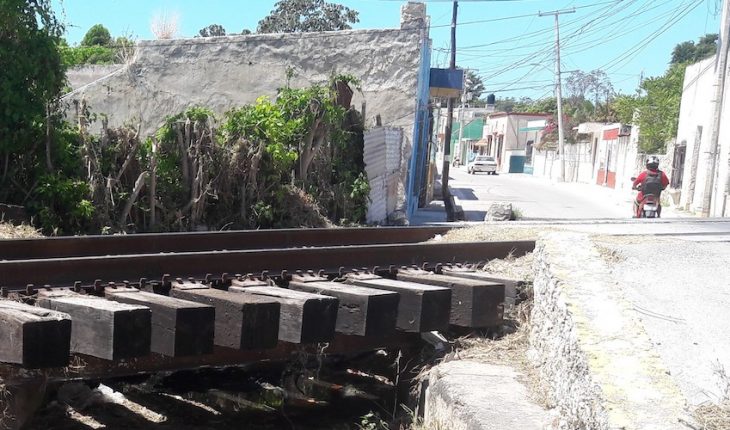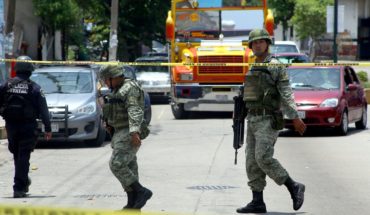In the neighborhoods of Camino Real, La Ermita and Santa Lucia in Campeche, dozens of families have lived for decades by the train tracks. But they came first, some have property titles from the late 1800s.
They are now at risk of having to leave homes where they were born and raised, not only their parents and grandparents.
The Maya Train, run by the National Tourism Development Fund (Fonatur), will pass through the area and the houses get in the way. The section of the mega construction that will pass through that area is the 2, which has already been licensed and won by the consortium composed of Operadora CICSA S.A. de C.V. de Grupo Carso, by Carlos Slim, in partnership agreement with FCC Construcción S.A.
In these three neighborhoods they are used to living at the foot of the Chiapas-Mayab railway track: there are houses that are three or four meters from the railway line, which began to be built in 1935.
Read more: Tourism will have fewer resources to attract visitors by 2021; 94% of your budget will be for Tren Maya
Families have grown up along with those machines that go about 40 kilometers per hour and have caused accidents ranging from derailments to hit-and-run.
“It is five or four generations that we have lived here. In 1938, at the bee of General Lázaro Cárdenas, they made the laying of tracks and did not give us a penny because according to it was a donation,” says Doña Guadalupe.
Joaquín Hidalgo Gutierrez/Courtesy
With the Maya Train there will be no way to live together, the speed it will reach will be more than 100 kilometers per hour and it is already stipulated that on 20 meters on one side and 20 meters on the other of the track there can be neither houses nor anything. If the project is done here, families would have to leave and many don’t want to.
The unconformed neighbours have a clear demand: the ones that must leave are the train tracks. That is the phrase that repeated over and over again the dozen neighbors of the three neighborhoods with which Political Animal held telephone talks to understand why it is not so easy for them to just accept a house and walk the other way.
José Medina, made his mechanical workshop next to his house, on Camino Real. It already has its clientele well tied up after almost 50 years of living and working in the area. When he’s 72, moving his business somewhere else becomes impossible for him. He’s no longer old enough to start over somewhere else, he says.
Candelario Pérez also has in his home, although he in the neighboring neighborhood of Santa Lucia, his electronics repair business. His wife, Luz del Carmen Gutiérrez, is retired and entertains the hours of the day taking care of the trees in her yard. There’s lemon, soursop, caimito, black zapote and chicozapote, plus many plants.
Find out: Revenue will fall by 2021, but government will spend more on Tren Maya, Dos Bocas and Santa Lucia
The houses, they claim, were already here since before 1899 when the concession was granted for the construction of the railway track that connects the city of Campeche with the rest of the Yucatan Peninsula. The Revolution stopped work, which continued after 1935.
“They wanted to point us out of invaders. They say the houses invaded the track area and it’s a lie. I have documents that support my family’s possession for 128 years. But the federal government passed the road through the property. As he asked them to donate land, but to those who did not accept, they just threw the machines at them. The plots, the courtyards, departed in two,” says Ms Guadalupe.
Juan Gómez, from the La Ermita neighborhood, points out that the above is so true that his family’s property was left on the road. “They split it in half, now my brother has his house on one side of the track and I’m on the other.”
Neighbors also complain that because the authorities handled everything as a donation of land from families, they have never been paid anything eer right of way or compensation.
“And now we’re not going to receive any money from them. We don’t want any money. We want you to take the roads that came to invade the properties of our families. Here, in this house where I am, they have lived since my great-grandparents and there was no way, what they passed were wagons,” says Aurora Concepción Campos, inhabitant of the Camino Real neighborhood.
You may be interested in: ‘We’re facing a dirty government campaign’;,” OSC says of AMLO’s accusations over the Maya Train
The villagers of the three neighborhoods, who even formed a collective to defend their homes, admit that there are neighbors who have already accepted relocation. But they attack that they are the ones who have lived in the area for the least time, without the thrown roots that those who were born here have and inherited the terroir from their ancestors.
José Arteo is a fisherman. He has his house five minutes from the sea, in the Camino Real neighborhood, in the city of San Francisco de Campeche. Carmen Castillo also lives in that neighborhood. He argues by selling breakfasts to fishermen. Every morning he grabs his tricycle, settles food and pedals to the beach. It takes 10 minutes to get there.
Moreover, they say, that there are not so many who have agreed to leave, are not 80% as the authorities say.
There is another thing that the dozen inhabitants repeat, words more, words less: “We do not oppose the Maya Train. But there are other places you can pass the road and not in the middle of the city. Now you could correct the mistake of exposing people to live by the train.”
UN-Habitat and the Census
Fonatur ruled that the most viable alternative to maintaining a Maya Train station in the campechana capital is the rehabilitation of the railway line currently in use, a statement dated 20 June points out.
The modernization of this road involves ensuring a distance with the surrounding homes that allows the construction and operation of the train without compromising the safety of the inhabitants during and after construction.
According to the final traces of the route of the train elaborated by Fonatur, in the case of San Francisco de Campeche, the premises (to be moved) are located on the east side of the track, in the colonies Camino Real, Benito Juárez, Bellavista and Santa Lucia, where the hill of Fort San José el Alto is located, “without having to affect the properties located on the other side of the road”, says the communication.
Read more: AMLO says NGO protection against Tren Maya has political tints
Fonatur assures in the communiqué that he will compensate in a fair and appropriate way to all the families of Campeche that result with his property impacted as a result of these works; he commissioned the United Nations Human Settlements Programme, UN-Habitat, to develop a Consensus Relocation Protocol.
Compliance with this Protocol by Fonatur and the competent authorities means that there is no forced eviction and that families participate in decision-making throughout the process and can choose the best option.
Joaquín Hidalgo Gutierrez/Courtesy
Among these, the statement says, highlights the financial compensation and advice for the construction or extension of a property on the current premises, outside the right of way, which could be applied in many cases if families so desire.
The protocol made public by UN-Habitat considers conducting a census, to make a socio-territorial diagnosis.
The neighbors interviewed complained that the UN agency went ahead with visits to houses in the midst of the COVID-19 pandemic, although federal authorities determined that surveys and censuses should stop (Article One, paragraph Vll of the Agreement establishing extraordinary actions to address the health emergency).
Find out: By the Maya Train, Fonatur plans to tear down thousands of trees
Indeed, on 4 April UN-Habitat announced that in coordination with the state government and the municipality of Campeche, interviews with neighbors, whether telephone or face-to-face, residing next to the train tracks, would take place from 13 to 20 April in the colonies Camino Real, Bellavista, La Ermita and Santa Lucia.
UN-Habitat’s work will be just an intermediary. The agency told Animal Politics that this UN office will not determine where people will move and only facilitate negotiations, but does not conduct them.
“The role of UN-Habitat is to listen to families (interview them), collect their doubts, proposals and interests and ensure that their rights are respected before, during and after Fonatur’s relocation.
Regarding what will happen to families who do not want to move, UN-Habitat responds that “in cases where consensual relocation is not possible, disputes will be resolved through the competent authorities, without any intervention by the United Nations agency”.
Neighbors dissatisfied with the entire procedure were grouped into the collective “The Three Neighborhoods” and on 17 April they filed an anti-eviction protection.
Arguing that only urgent cases were being admitted by the pandemic, the court did not wish to receive the protection, says Carlos Escoffié, who leads the defense of the unconformed neighbors. They then had to appeal the complaint to the Collegiate Court.
This body asked them to sign the application not only one person, on behalf of the rest, but all those who wished to join, and to attach official identification and proof of domicile.
You may be interested: Six deputy directors of the Conagua resign, following AMLO’s warning
“They signed 226 neighbors of Camino Real, Saint Lucia and La Ermita”, says Guadalupe Gutiérrez. Animal Politics has a copy of the list of those signatures.
After this proceeding, on May 6, the Campeche-based District First Court granted the provisional suspension, but not for the likely relocation if it not only ruled for suspending the census and face-to-face interviews that were already underway. The census continued over the phone.
What do those who want to leave ask for
On 30 March, UN-Habitat released the first results of that exercise.
So far, UN-Habitat, says the document, has contacted a total of 119 people (67 women and 52 men) from the neighborhoods of Camino Real, Santa Lucia and Bellavista. Of these, 84% claim to be in favor of possible relocation, while 16% reveal their dissatisfance with this.
On an information card, Fonatur acknowledges that “there are various tensions due to clarification of the final stroke and compensation processes”.
It ensures that the locations will be carried out through dialogue and contemplating at all times the well-being of people.
“Where relocation processes are required, it will be analyzed on a case-by-case basis and will seek to increase people’s quality of life. In cases of invasions of road rights or federal property, families who by necessity have made their lives on these lands will be recognized.”
Among those who have expressed their opinion in favour is the idea that the Maya Train will bring economic benefits to the state of Campeche and improve the living conditions of families, as well as their safety in the face of possible derailments, according to the report.
“I’ve been living on the Camino Real for 39 years. It hurts me to have to leave my house. I bought the house, I set up my business and I live on sales, from the people in the neighborhood. Going somewhere else is to start over, but I’m aware that it’s for campeche’s improvement, for the improvement of ourselves. The train pass breaks the house’s glass and quasses the roofs. We’re taking our chances. It is better to be off the track,” says one of the neighbours according to the UN-Habitat Mexico report.
Another reason to move, as required in the document, is the need to order the legal status of the houses, since some houses originally belonged to a single property.
Read more: Campeche, first state to move to COVID green traffic light; there are 16 entities in yellow
In other cases, the possibility of a swap in another city is negotiated: “I was offered work in Ciudad del Carmen, but there the rent is higher, twice as high as here. Even though we rented the house, it’s not enough for us. For us, the option would be a house in Ciudad del Carmen”, it is based on another testimony of the UN-Habitat report, although none are accompanied by name.
In order to give their consent to relocation, the report is agreed upon, the neighbours interviewed stress the need for a “fair negotiation”, which excludes the transfer to houses of social interest removed from the area – “on the periphery” – or the delivery of homes with less value than the current home.
Another of the demands involves taking into account the specific needs of the population, especially those who work in fishing and require mobilization near the area both in times of fishing activity, and for the shelter of their vessels during weather events.
Joaquín Hidalgo Gutierrez/Courtesy
Where sanitary conditions permit, the document notes, applying the health protocols made by Fonatur and verified by the Ministry of Labour, UN-Habitat will organize briefings with families residing along the train track.
Interviews with neighbors will also continue on the characteristics of the homes and the socioeconomic conditions of those who live in them, as well as their willingness to accept the relocation process and, in any case, their preferences among the different options that each family group proposes, so that Fonatur can implement them.
On August 6, the neighbors’ defense filed an extension of the demand for shelter filed in April, this time calling for the train’s stroke to move and work not to begin in the area that encompasses the three neighborhoods, Explains Escoffié.
The judge granted the protection on August 25, but avoided ruling on whether or not he would give the suspension
So far, says Carlos Escoffié, a lawyer for those affected, “families are in uncertainty and fear of eviction because they have not been clearly told who would be relocated where or how.”
The process, the Fonatur card points out, is maintained at the census stage. The roadmap will be announced in the followingmonths. And he stresses that UN-Habitat is providing technical advice and brings with it international best practices.
What we do at Animal Politics requires professional journalists, teamwork, dialogue with readers and something very important: independence. You can help us keep going. Be part of the team.
Subscribe to Animal Politics, receive benefits and support free journalism.#YoSoyAnimal





